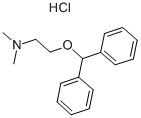Dibucaine hydrochloride
Synonym(s):2-Butoxy-N-(2-diethylaminoethyl)-4-quinolinecarboxamide hydrochloride;Cinchocaine hydrochloride;Dibucaine hydrochloride
- CAS NO.:61-12-1
- Empirical Formula: C20H30ClN3O2
- Molecular Weight: 379.92
- MDL number: MFCD00012735
- EINECS: 200-498-1
- SAFETY DATA SHEET (SDS)
- Update Date: 2025-03-03 14:10:04

What is Dibucaine hydrochloride ?
Chemical properties
white powder
The Uses of Dibucaine hydrochloride
Cinchocaine is used as an anaesthetic agent for spinal anaesthesia; a component in rectal medications used in inflammation of the anus and for the symptomatic treatment of hemorrhoids and fissures in the anus; local anesthetic agent.
The Uses of Dibucaine hydrochloride
Dibucaine HCl is an amide-like quinoline derivative and is one of the most potent and longest acting of the commonly used local anesthetics.
Definition
ChEBI: The monohydrochloride salt of cinchocaine. It is used in creams, ointments and suppositories for temporary relief of pain and itching associated with skin and anorectal conditions.
brand name
Nupercaine (Novartis).
Contact allergens
Dibucaine hydrochloride is an amide group local anesthetic that can induce allergic contact dermatitis.
Safety Profile
Poison by ingestion,subcutaneous, intravenous, intraspinal, parenteral, andintraperitoneal routes. Mutation data reported. A severeeye irritant. A local anesthetic. When heated todecomposition it emits very toxic fumes of HCl and NOx
Mechanism of action
Dibucaine hydrochloride is an amide-type local anesthetic. Local anesthetics block both the initiation and conduction of nerve impulses by decreasing the neuronal membrane's permeability to sodium ions through sodium channel inhibition.
Properties of Dibucaine hydrochloride
| Melting point: | 99-101 °C(lit.) |
| Density | 1.1338 (rough estimate) |
| refractive index | 1.5400 (estimate) |
| storage temp. | Refrigerator |
| solubility | DMSO (Slightly), Methanol (Slightly) |
| form | Solid |
| color | Hygroscopic crystals |
| PH | pH(20g/l,25℃) : 5.0~6.0 |
| Water Solubility | Freely soluble in water, alcohol, acetone, or chloroform |
| Merck | 13,3057 |
| Stability: | Stable. Incompatible with strong oxidizing agents. Protect from moisture. |
| InChI | InChI=1S/C20H29N3O2.ClH/c1-4-7-14-25-19-15-17(16-10-8-9-11-18(16)22-19)20(24)21-12-13-23(5-2)6-3;/h8-11,15H,4-7,12-14H2,1-3H3,(H,21,24);1H |
| CAS DataBase Reference | 61-12-1(CAS DataBase Reference) |
Safety information for Dibucaine hydrochloride
| Signal word | Danger |
| Pictogram(s) |
 Corrosion Corrosives GHS05  Exclamation Mark Irritant GHS07 |
| GHS Hazard Statements |
H302:Acute toxicity,oral H318:Serious eye damage/eye irritation |
| Precautionary Statement Codes |
P280:Wear protective gloves/protective clothing/eye protection/face protection. |
Computed Descriptors for Dibucaine hydrochloride
| InChIKey | IVHBBMHQKZBJEU-UHFFFAOYSA-N |
| SMILES | C12C=CC=CC1=NC(OCCCC)=CC=2C(=O)NCCN(CC)CC.Cl |
New Products
1-Boc-4-cyanopiperidine tert-Butyl carbazate 1-(TERT-BUTOXYCARBONYL)-2-PYRROLIDINONE TETRABUTYLAMMONIUM CYANIDE TETRAHYDRO-2H-PYRAN-3-OL 3-Pyridineacrylic acid Nickel(II) perchlorate hexahydrate, 98% 4-Bromophenylacetonitrile, 95% 3-Bromo-4-fluoroaniline, 97% Sodium tetraborate decahydrate, 98% Palladium(II) acetate, trimer, Pd 99% 4-Bromo-2-chlorotoluene, 97% Tadalafil Clopidogrel bisulfate Sitagliptin Phosphate Monohydrate Cabergoline Fexofinadine HCl Etoricoxib 4-Amino Acetophenone 2-Chloro Acetophenone Amlodipine Base 2,3,5-Triiodobenzoic Acid Pyrrolidine Diiodo PentoxideRelated products of tetrahydrofuran








You may like
-
 61-12-1 Dibucaine Hydrochloride 98%View Details
61-12-1 Dibucaine Hydrochloride 98%View Details
61-12-1 -
 61-12-1 99%View Details
61-12-1 99%View Details
61-12-1 -
 Dibucaine hydrochloride 61-12-1 98%View Details
Dibucaine hydrochloride 61-12-1 98%View Details
61-12-1 -
 Dibucaine HCl 97% CAS 61-12-1View Details
Dibucaine HCl 97% CAS 61-12-1View Details
61-12-1 -
 Dibucaine hydrochloride CAS 61-12-1View Details
Dibucaine hydrochloride CAS 61-12-1View Details
61-12-1 -
 366789-02-8 Riveroxaban 98%View Details
366789-02-8 Riveroxaban 98%View Details
366789-02-8 -
 Carvedilol 98%View Details
Carvedilol 98%View Details
72956-09-3 -
 73590-58-6 Omeprazole 98%View Details
73590-58-6 Omeprazole 98%View Details
73590-58-6
